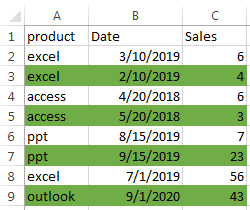


Now use the formula for the next row! The =MOD(4,2) expression will get 0, so it does not meet our criteria, and the row remains unchanged. Method 3: Select Every Other Row Using VBA. Method 2: Select Every Other Row Using Helper Column & Filter. Method 1: Select Every Other Row Manually. Once selected, you can work with these selected rows accordingly. If you are unfamiliar with Excel shortcuts, click on the Home tab, select Conditional Formatting, and choose New Rule.Įvaluate the formula! Because the ROW function returns 3 =MOD(ROW()),2)=1Įxcel will compile the formula into the following: =MOD(3,2) = 1Īs a result of the formula, Excel highlights the first row because the result meets our initial criteria. In this tutorial, we are going to go through three different ways of selecting every other row in Excel. Save your time using keyboard shortcuts! Use the Alt + O + D shortcut to open the conditional formatting rules manager window.ģ. To quickly highlight every alternate row in Excel, follow the steps below:Ģ. We shade every other row in the B3: D13 range in this example. Shade alternate rows using the ISEVEN function

#Undo excel highlight every other row how to
How to highlight every other row in Excel using Conditional Formattingįrequently facing the problem: It would be great to highlight rows in Excel! Conditional formatting is a versatile tool for highlighting rows, columns, and values colors, so we’ll use it in this example. Finally, we’ll write a short macro to get the work even faster for shading every other row. After that, we’ll introduce the excel-table based solution. In this Excel guide, I will cover the following topics:Īt first, you’ll learn how to highlight every other row using conditional formatting. Working with large data tables and organizing ranges in Excel is sometimes not too easy. Then, to improve your spreadsheet’s readability, alternate shade rows! This tutorial will explain how to highlight every other row in Excel.


 0 kommentar(er)
0 kommentar(er)
